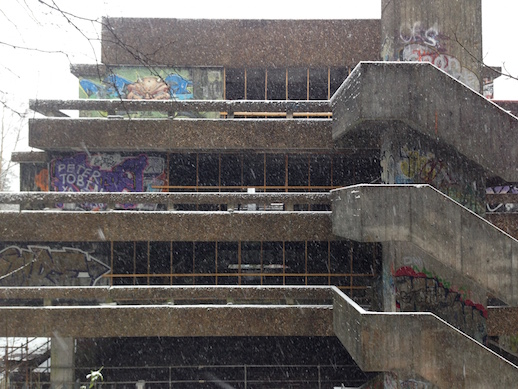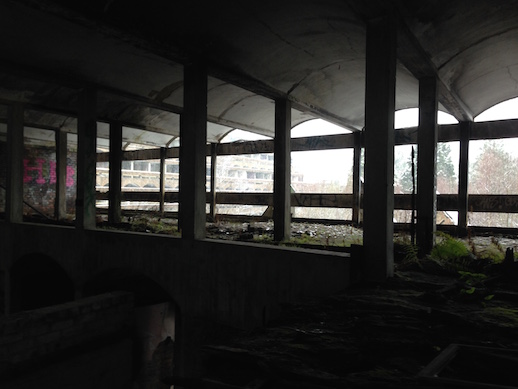 Words and pictures: Alister Wedderburn
Words and pictures: Alister Wedderburn
Driving westwards out of Glasgow, it started to snow. The world was white by the time we arrived in Cardross, about twenty-five miles down the north bank of the Clyde, and we emerged out of the car into the muted hush that always accompanies snowfall.
We had come to see St Peter’s Seminary. Hidden away above the village, tucked invisibly within woodland and half a mile from any public road, St Peter’s is one of the fruits of the Catholic Church’s unexpected turn towards architectural modernism in the 1950s and 1960s. Designed by Isi Metzstein and Andy MacMillan, the seminary is a playground of concrete shapes and forms, a brutalist spaceship come to earth among the trees, quietly biding its time.
Its time is yet to come, if it is ever to come at all. Begun in 1961 and finished in 1966, St Peter’s was intended to provide a space in which trainee priests could live and learn in reflective solitude. The second Vatican Council, however, which sat between 1962 and 1965, placed a renewed emphasis on pastoral work in the ordination process. Seminaries were therefore to be implanted within communities, not isolated from them. In this sense, St Peter’s was obsolete before it had even been built. Faced with an ever-dwindling number of novitiates, it closed in 1980.
Unoccupied and untended since then, thirty-odd years of rain, wind, and unauthorised human invasion have inevitably left their stamp. But St Peter’s is still there, squatting down among the trees in a dishevelled sulk, and I had long wanted to visit. Now taken over by Scottish public arts organisation NVA, the seminary is about to be turned into an exhibition and performance space: in March, it will host the launch event for Scotland’s 2016 Festival of Architecture. But I wanted to see St Peter’s before then, in order to experience the building directly and, I hoped, in a more affective, personal way than a public event could allow.
Leaving the car behind us, we hopped over a long-collapsed wall and walked down a track towards the seminary. Our footprints were one of a number of impressions in the inch or so of snow: the track bisected a golf course, and the trails left by buggies and carts streaked across it at irregular intervals. The woods began at the course’s eastern edge.
The main entrance, a bridge over Kilmahew Burn, was fenced off. On the other side of the stream, the top of the seminary’s living quarters peeked at us through the naked boughs as though through fingers, high up to our left. We scrambled down to the water in order to find a crossing point, and eventually discovered the skeleton of a footbridge, with a trellised arch standing at one end like a portal, a snow-capped fringe of ivy breaking across it. We tiptoed over, scrambled up the opposite bank, and came face-to-face with a large wall coated with moss and mould.

In 1972, Scottish director Murray Grigor made a twenty-minute film about St Peter’s called Space and Light. Grigor’s film has action shots of sorts: it shows trainee priests walking down passages and sitting down to dinner, nuns chanting the Hail Mary, as well as snippets of a Mass. But it is St Peter’s itself that is undoubtedly the focus: almost every shot is designed to accentuate the angles, curves and depths of the building. The impression given by Grigor is of a constant dialogue between concrete and light, and his film conveys the sense that these heavy slabs and pillars might, for all their weight and density, be on the verge of lifting off. As with other, similarly audacious buildings of the period (the cathedrals of Brasilia and Rio de Janeiro, or le Corbusier’s Convent Sainte-Marie de la Tourette), the force of St Peter’s, in Space and Light at least, is generated by the effect of weightlessness created when its heavy walls are cut open: the contrast between concrete slabs and the bright white shafts that spear in from multiple directions.
In the snow, under a grey January sky and the burden of thirty years’ decay, St Peter’s felt very different. We walked around its perimeter, standing underneath the cantilevered point of the old teaching block, and we looked through the vacant buildings into the central court. Loose bricks and rubble littered every floor, while mould crawled up most of the walls. The rooms were cave-like; filled with the sort of darkness that one felt might overwhelm any light brought to illuminate it. The windows were hollow. Rather than ascending into the heavens, as in Grigor’s film, St Peter’s now appeared to be sinking into the ground. Its dereliction had certainly frayed and blurred the edge that once separated it from the forest that has always grown around it and now increasingly probes within. Maybe this earthiness will make it a more successful arts venue than it was a seminary: it certainly deserves to be more than nothing. But as we walked back across the golf course to the car, my overwhelming feeling was one of gloom. I’d come expecting a ghost, but had found a corpse.